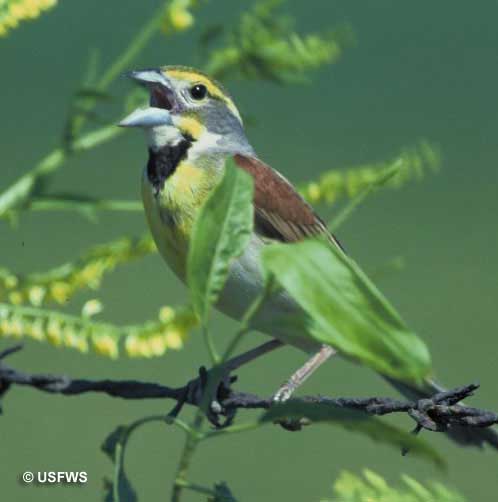
Oklahoma is a medium-sized state situated in the south-central part of the USA. It borders Kansas to the north, Texas to the south, and Arkansas to the east, and has a population of 4,019,800. Known as the “Native America” state and the “Sooner State,” Oklahoma also has 69,898 square miles of prairie habitats, woodlands, farmlands, and wetlands.
These habitats are home to many bird species, including the Oklahoma state bird, the Scissor-tailed Flycatcher.
This elegant bird is a pale gray flycatcher with salmon-colored highlights and an elongated forked tail. It is common throughout Oklahoma.
In this article, you’ll find all the necessary birding information about Oklahoma – the most common birds, hawks, owls, and woodpeckers.
On this page
Oklahoma Birds
According to the North America Breeding Birds Survey in 2021, these are the most popular birds in Oklahoma. We’ve added Oklahoma’s most popular hawks, owls and woodpeckers to this list as well for you. Enjoy!
Dickcissel
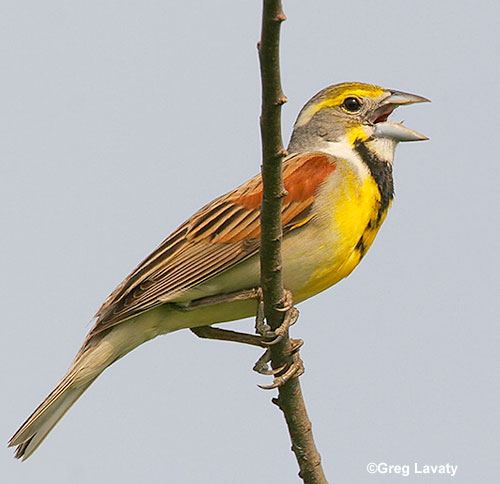
The Dickcissel is a small and colorful, sparrow-like bird of open habitats. The male is grayish and brown with a yellow eyebrow, yellow mustache mark, and a yellow patch on the breast. It has a black and white throat, dark streaks on the back, and rufous shoulders in its wings.
Like the male, the female Dickcissel also has a strong, conical, grayish beak. She looks like the male but is more brown instead of gray, and has less yellow on the face and breast.
Dickcissels forage in grasslands for grasshoppers and other small insects. They also use their thick bills to crack open and eat a variety of seeds and grains. After breeding, these birds love to form flocks. Hundreds of Dickcissels can flock together, many of them wintering in rice fields and other open habitats in Central and South America.
One of the key birds of Oklahoma, the song of this species is often heard from open, grassy habitats. It is a short song that sounds a bit like its name, “tick-su su su!”
Cliff Swallow
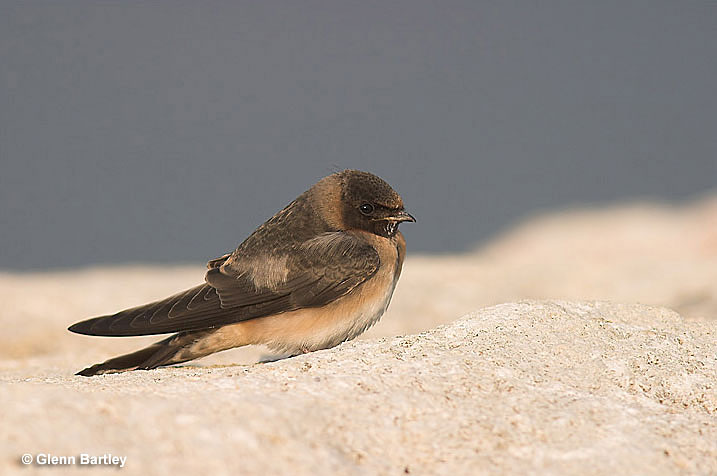
The Cliff Swallow is a hefty swallow species with a pale spot above the beak and a pale rump. It has a dark rufous throat and sides of the neck, and pale underparts with a grayish wash on the chest and flanks. This swallow species also has a narrow pale collar, a blackish-blue cap, and a blackish-blue back with some white streaks. Its long wings are dark, and it also has a dark, slightly forked tail.
Both sexes of the Cliff Swallow look the same, but juveniles look different. These young birds have the same pattern and pale rump of the adults but are darker and duller.
Cliff Swallows forage for small insects and other arthropods. Like other swallows, they catch their food with their wide mouths in flight.
In Oklahoma, they fly over a variety of habitats, especially open fields and wetlands. As in other parts of its range, it nests in colonies under culverts, bridges, and other structures. Cliff Swallows fly to South America for the winter.
Mourning Dove
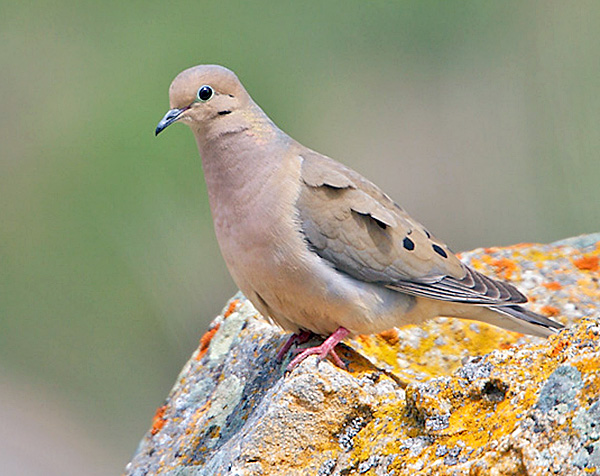
Photograph © Greg Lavaty.
The Mourning Dove is a pale brown, buff, and gray dove with a long, pointed tail. This dove species also has a small head with a narrow gray eyering, some black spots in the wings, and some white edging on its tail. Both sexes look the same although only males sing. They give a commonly heard, mournful and deep “Who, who who who..” song that is frequently mistaken for an owl.
Mourning Doves are very common birds in most of their range. In Oklahoma, we see them in farm habitats, woodlands, urban areas, and other places. They are also frequent visitors to feeders.
These long-tailed doves eat seeds and grain. They usually pick food from the ground but can also perch on feeders. In backyards, we usually see just one Mourning Dove or small groups of this bird.
However, after the breeding season, Mourning Doves flock together. In the winter, we can find groups of a dozen or more feeding in farm fields and other open situations.
Western Meadowlark
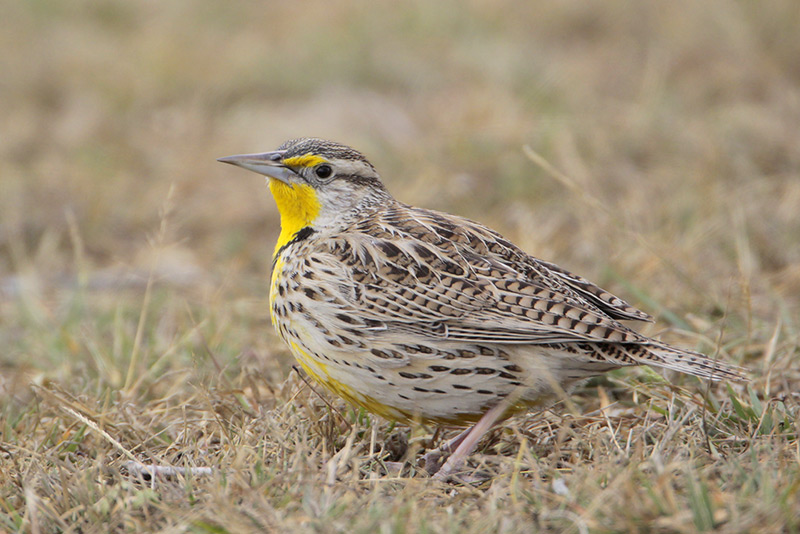
The Western Meadowlark is a chunky, pale brown and yellow bird with a short tail, and long pink legs. It has a long, pointed gray beak, a black, “V” shaped mark on a yellow breast, and a yellow throat. This conspicuous bird also has a white face with yellow in front of the eye, and a dark line going back from the eye.
Western Meadowlarks have fine pale streaking on a dark crown, dark streaks and barring on pale brown upperparts, and some dark marks on white flanks. In flight, the white edges of the pale brown tail are noticeable.
The Western Meadowlark walks in prairies and other open habitats to feed on grasshoppers and other insects. This species also loves to sing from posts and other open spots. The commonly heard song is an essential part of the avian soundscape in central and western Oklahoma.
The short flute-like, warbling phrases are one of the ways to separate this species from the very similar Eastern Meadowlark. They can occur together but Western Meadowlarks prefer more open, arid habitats. They also have a bit more yellow on the lower side of the face.
Northern Cardinal
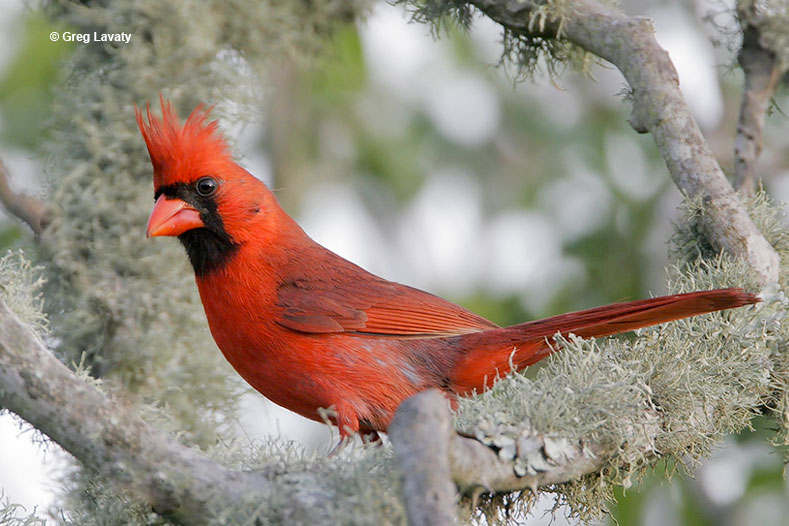
The Northern Cardinal is a striking bird with a reddish-orange, deep and conical beak, black face, and a long crest. The male is bright red with duller red in the wings and tail. Female Northern Cardinals are buff and brown with red highlights in the crest, wings, and tail.
This species is one of the most beautiful birds of Oklahoma. Thankfully, it’s also a common species of gardens, parks, and other edge habitats. In Oklahoma, as in other parts of their wide range, Northern Cardinals feed on seeds, fruits, and insects. They use their big, strong bills to crack open sunflowers and other types of seeds. This bird often visit feeders.
Northern Cardinals fly with rounded wings, and have undulating flight where the bird goes up and down. In flight, the rounded tail of this species is also more evident.
Males sing a cheerful, whistled “What cheer! What cheer! What cheer! Chew-chew-chew-chew” song. Female cardinals also sing but less often than males, and mostly when they are on the nest.
Eastern Meadowlark
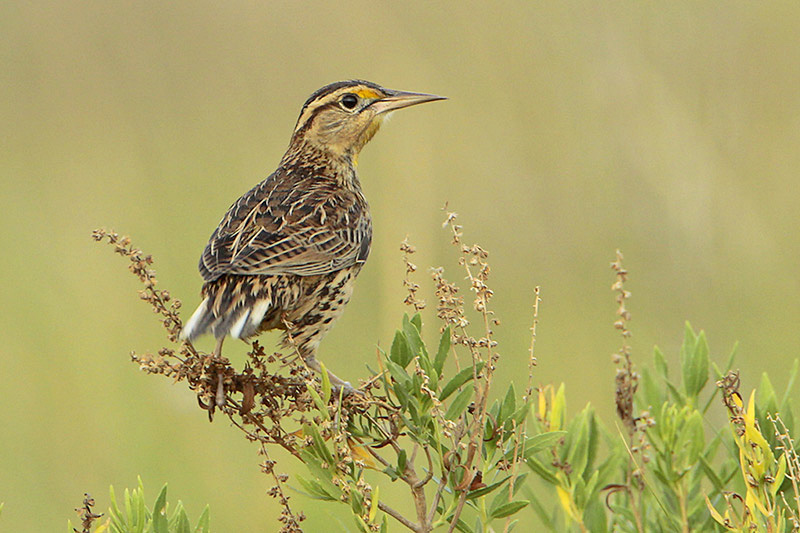
The Eastern Meadowlark is pale brown, yellow, and rotund. It has a short pale brown and white tail, and long pink legs. This blackbird species also has a yellow breast with a black, “V”-shaped mark, yellow throat, and yellow in front of the eye. The white face has a dark line going back from the eye, and the crown is dark with pale streaks.
Eastern Meadowlarks have dark streaks and barring on pale brown upperparts, and some dark marks on white flanks. Like the closely related Western Meadowlark, this species often sings from a low perch or on the ground. However, its flute-like phrases lack the warbling character of the Western Meadowlark song.
This species walks through prairies and other grassy habitats to feed on insects. It looks very similar to the Western Meadowlark but has less yellow on the face and a different song.
Red-winged Blackbird
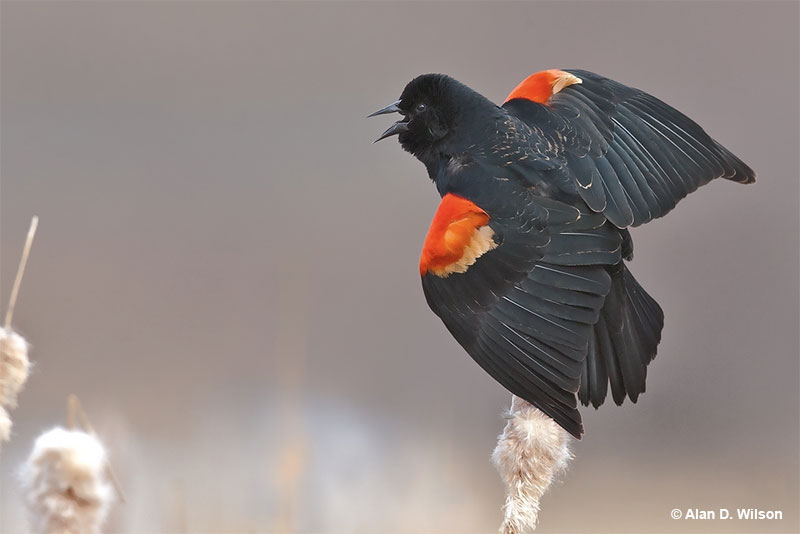
The Red-winged Blackbird is a common bird of wetlands and other open, brushy habitats. Males are black with a striking red shoulder. This red patch has a narrow yellowish border and is partly concealed when birds forage. However, when the male Red-winged Blackbird sings, it extends and showcases these bright scarlet wing patches. This red patch is also obvious in flight.
Female Red-winged Blackbirds look very different from males. Like males, they also have a sharp, black beak, but lack black plumage. They have streaked grayish-brown plumage with rufous highlights on the back and in the wings. Juvenile birds are dull black or dark gray with some brown mottling, and a bit of orange on the shoulder.
This species eats grain, seeds, and insects. It uses its sharp bill to pick food items from the ground and from low vegetation. This blackbird species often feeds in large flocks, especially in the winter. When flocking, it can also forage with grackles, starlings, and other blackbirds.
In spring and summer, the male’s loud “kon-ker-ee!” song is often heard in wetland and brushy habitats in Oklahoma.
Horned Lark
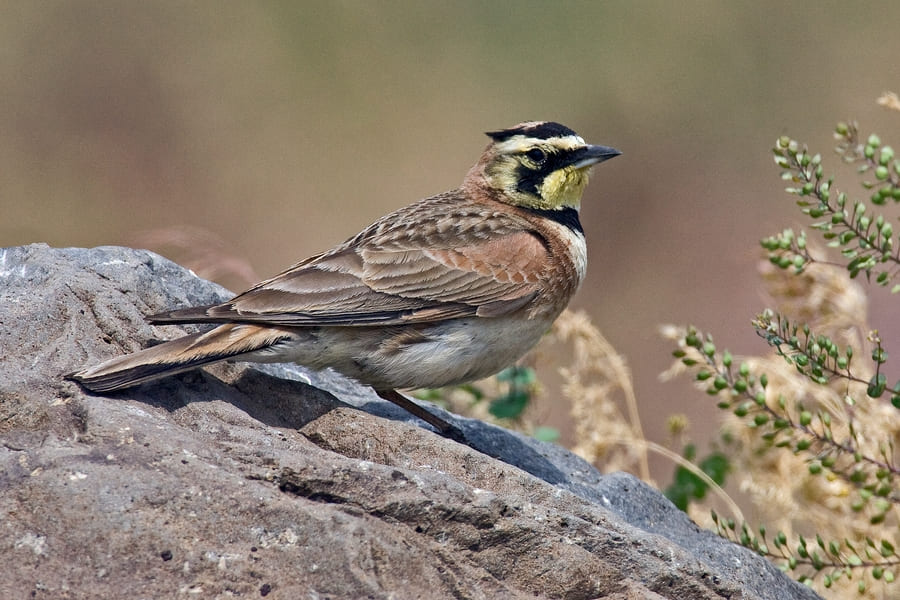
The Horned Lark is a small, unique bird with a prominent black mask, black breastband, and short, black horn-like tufts on its head. It has a slight, grayish beak, pale yellow or white eyebrow, and yellow on the throat. The Horned Lark also has grayish-brown and rufous upperparts and flanks, and a dark tail with white outer tail feathers.
The female Horned Lark looks like the male but lacks the “horns”, is duller, and looks like a washed-out version of the male. Juvenile birds resemble females but are darker gray and with spotted upperparts.
The Horned Lark mostly feeds on small seeds but also eats some insects during the summer months. This species forages on the ground and often picks seeds from manure, roadsides, and farm fields.
Horned Larks are birds of wide-open spaces and have become adapted to living on grassy pastures and farm fields. The male has a tinkling, warbling song given from a perch and in flight. In winter, they can form large flocks.
American Crow
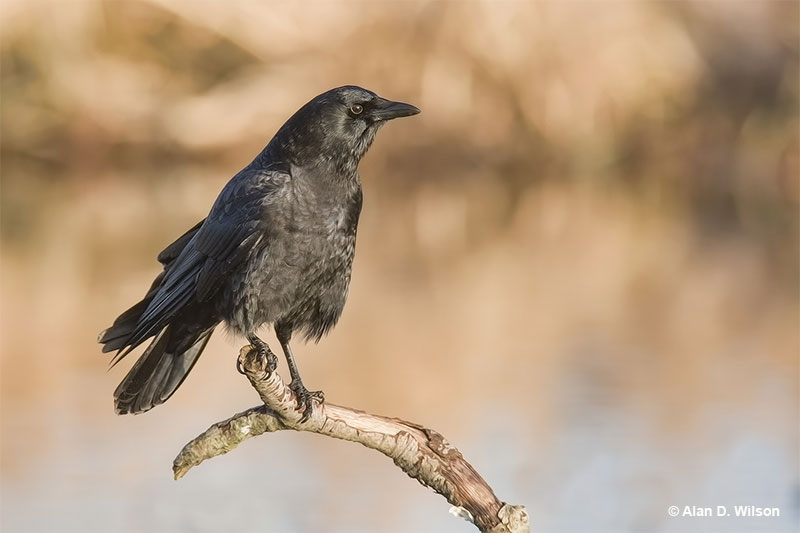
© Alan D. Wilson
The American Crow is a large, all black, and well-known bird. Both sexes of this common species are black with some dark blue or glossy highlights. These birds use their long wings to fly to and from roosting and feeding sites, and they have strong, black legs and feet.
American Crows use their stout black bills to feed on a wide variety of items. These omnivorous birds eat seeds, fruit, grain, carrion, garbage, and small animals. Like jays and other members of the Corvid family, in spring, American Crows attack the nests of other birds to eat the eggs and nestlings.
In Oklahoma, the American Crow is a common bird in farmlands, woods, and other habitats. The loud cawing calls of these vocal birds are often heard well before they are seen. They also flock together and, when mobbing owls, can reveal the location of those hidden birds to birders and photographers.
Amazingly, these smart birds can also be taught to say words! Similar to parrots, American Crows mimic many of the sounds they hear, including human speech.
Indigo Bunting
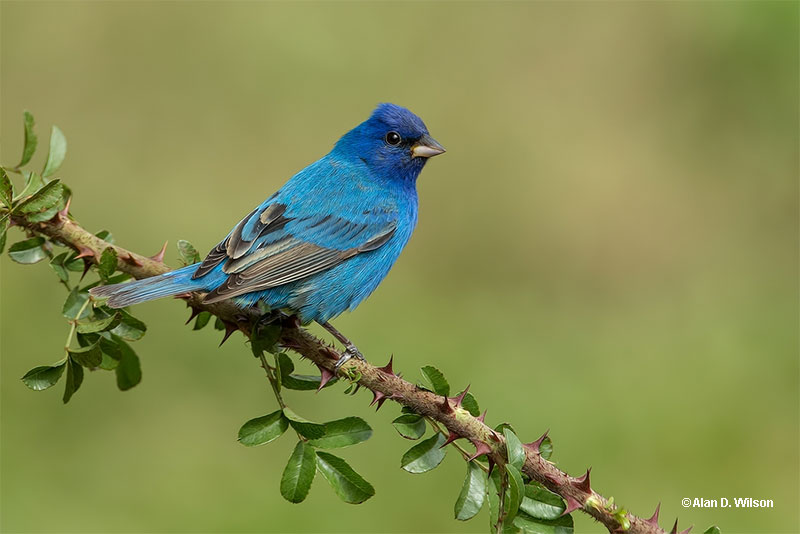
© Alan D. Wilson
The Indigo Bunting is a small, sparrow-like bird with a conical, grayish bill. The male is a beautiful deep blue with black in the wings, tail, and in front of the beak. The female Indigo Bunting looks very different. She is brown with some blue on the wings, rump, and tail, and has some brown streaks on pale underparts.
Sometimes, male Indigo Buntings look more black than blue, can appear dull blue, or show glowing sapphire-like plumage. These differences are because the blue color of this species is not actually related to pigment. Instead, the different shades of blue are related to the way light interacts with the structure of the feathers.
Indigo Buntings feed on insects and seeds. They use their beaks to pick food from grasses and other low vegetation, as well as from the ground. This species rarely visits feeders and is usually seen in young second growth, and other thick, brushy habitats.
In early summer in Oklahoma, we often hear males singing from power line cuts and forest edge. Their song is a brief series of descending chirping and warbling phrases.
Northern Bobwhite
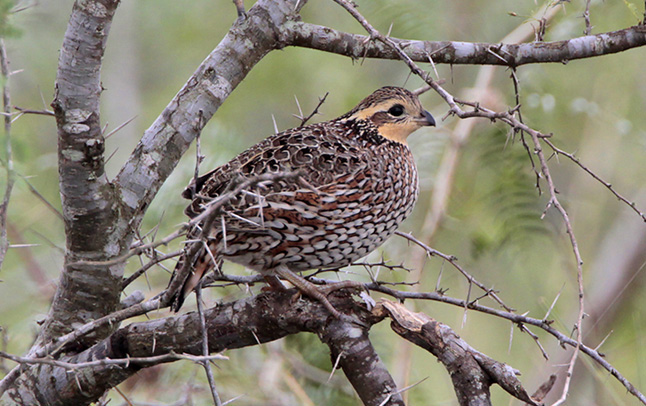
The Northern Bobwhite is a small, cute quail found throughout Oklahoma. The male of this terrestrial species is mottled brown and buff with black and white scaling on the underparts. He has a white throat bordered with black, a black and white face, and some white streaks on the sides and back of his neck.
The female Northern Bobwhite is similar but she has buff on the face instead of black and white. She and the male have lovely brown upperparts mottled with black and white.
This quail species uses its stout black bill to forage for seeds, grain, insects, and other small creatures. They spend all of their time on the ground, often hiding in grass and other cover. The Northern Bobwhite occurs in flocks of a dozen or so birds known as a “covey”. When alarmed, they burst into flight with whirring wings or quickly run away.
The song of the Northern Bobwhite is often heard in grassy and brushy habitats. The males sings a sweet, whistled, “Bob..white!” song from a low perch or from the ground.
Painted Bunting
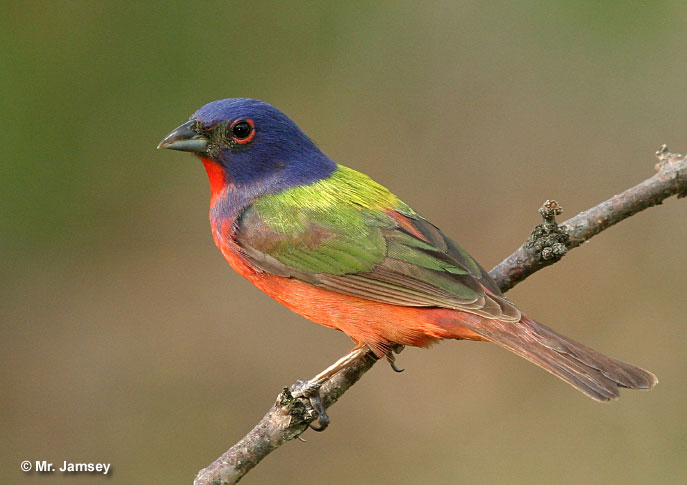
The Painted Bunting is a stunning, sparrow-sized bird of brushy habitats. The male has so many colors, he’s a good candidate for being the most colorful of the birds of Oklahoma. Male Painted Buntings have bright blue heads with a red eyering, and a red throat. Their back is lime green, and the rump, breast, belly, and undertail are red. The wings and tail are blackish with shades of dusky green and red.
The Female Painted Bunting doesn’t have the bright colors of the male but she’s still a pretty bird. She is green with a narrow yellowish eyering, yellowish underparts, and blackish wings and tail. Young males look almost exactly like females and are very hard tell in the field. to Both sexes have a gray, conical, finch-like beak.
This species forages down low and feeds on a variety of grass seeds along with some beetles, caterpillars, and other insects.
In spring and summer, the complex warbling song of the male Painted Buntings is a regular feature of second growth and brushy places.
Turkey Vulture
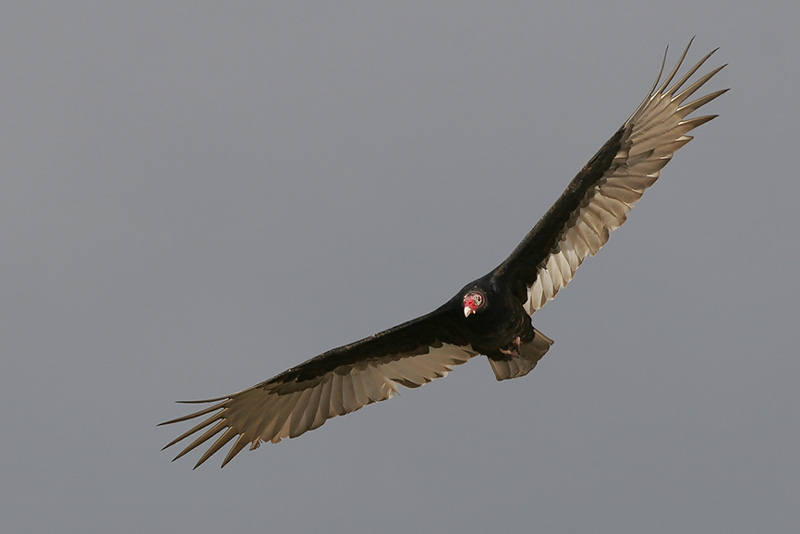
The Turkey Vulture is a huge, black bird with a naked red head. Its two-foot length and 67 inch wingspan make the Turkey Vulture one of the largest birds in Oklahoma. Both sexes look alike and have blackish plumage with some dark brown highlights. In flight, they hold their long wings in a “V” shape, have grayish flight feathers, and a fairly long tail.
Juvenile Turkey Vultures look like adults but have a blackish head. This scavenger has a pale bill with a hooked tip used to tear flesh from dead animals. This species only eats carrion and finds much of its food by sense of smell. Unlike many other birds, Turkey Vultures have an acute sense of smell tuned in to decaying animals.
After an animal dies as roadkill, on a farm, or in the wild, it doesn’t take long for a Turkey Vulture to find it. This large bird quickly eats the carrion but can be driven away from its food by Black Vultures.
In Oklahoma, Turkey Vultures can be seen soaring over most habitats and places.
Lark Sparrow
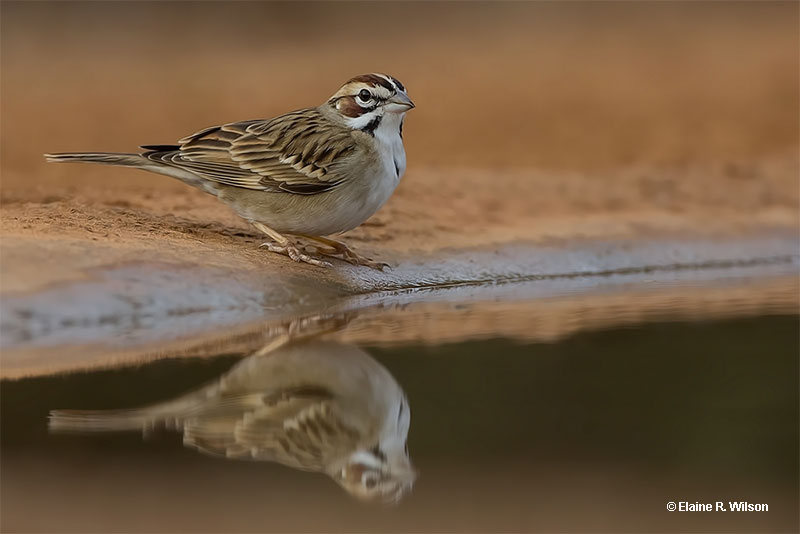
© Elaine R. Wilson
The Lark Sparrow is a good-sized sparrow species with a handsome chestnut pattern on its head, and large white markings in its tail. It has a chestnut ear patch, a chestnut crown with a white line down the middle, and a white eyebrow. This species also has a black line through the eye, and a white moustache with a black border.
The rest of the bird has grayish brown with a bit of white in the wings, white in the tail, and a small black spot on pale underparts. Male and female Lark Sparrows look alike and have pink legs, and a conical, grayish beak.
This species mostly feeds on various types of seeds but also eats some insects, especially during the summer. It uses its bill to pick food items from the ground, and, when not breeding, forages in small flocks.
In Oklahoma, Lark Sparrows are common birds in pastures and semi-open grassy habitats with scattered bushes and trees. During that time of year, we often hear their complex whistled and trilled song. In the fall, they migrate to Texas and Mexico for the winter.
Brown-headed Cowbird
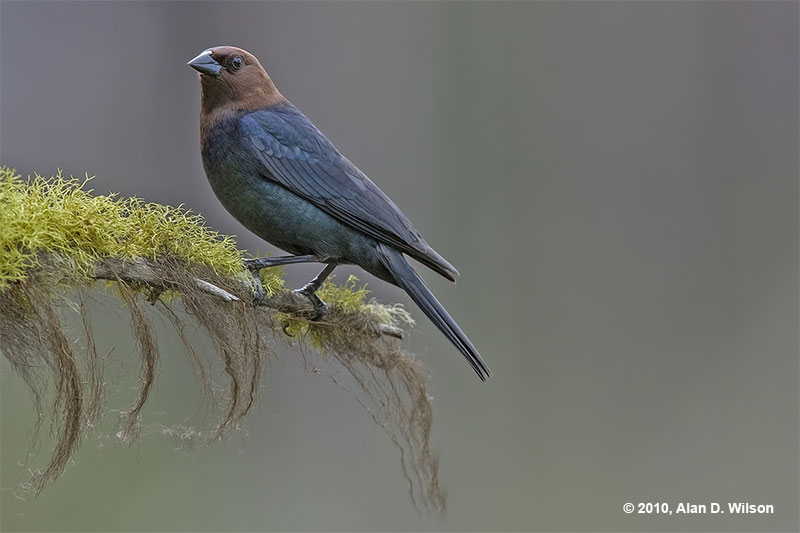
The Brown-headed Cowbird is a small blackbird species commonly seen in Oklahoma. The male Brown-headed Cowbird is black with some glossy, dark blue highlights, and has a brown head. The female is gray with some brown highlights and a white throat. Both sexes have long wings, a rather short tail, and a dark, slender, conical bill.
Brown-headed Cowbirds mostly eat seeds from “weedy” plants. They also eat some insects and other arthropods and take all of their food from the ground.
This species is a social bird that often flocks together. In the winter, they can form large flocks that frequent farm fields and other open habitats. True to its name, the Brown-headed Cowbird is often seen around cows. It probably evolved to feed with Bison and other large mammals, but in the absence of those animals, quickly adapted to foraging with cows.
This species can be seen in every habitat but is usually found in open areas. As with every part of its range, in Oklahoma, the Brown-headed Cowbird is an important nest parasite of other bird species.
Northern Mockingbird
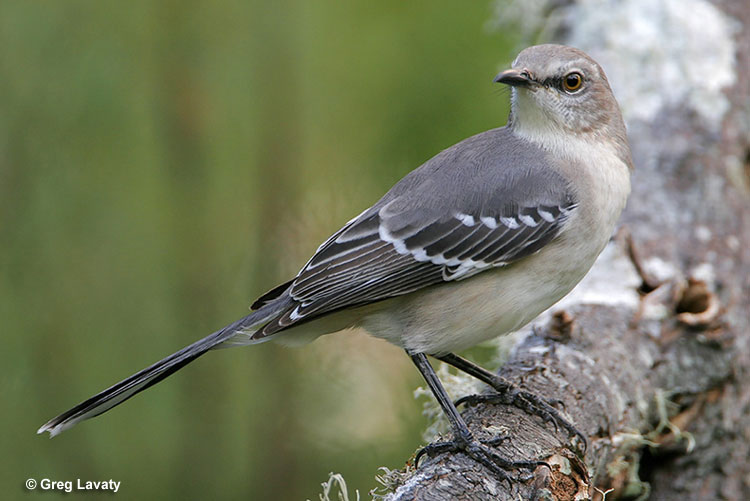
The Northern Mockingbird is a pale gray, robin-sized bird with a long tail. It is gray above, pale gray below with some buff on the flanks and undertail, and has a white throat. Northern Mockingbirds also have two white wing bars on blackish-gray wings, a narrow, broken white eyering, and a bit of black in front of the eye.
Both sexes look alike and also have much white in the tail, a pale eye, and a short black, slightly curved bill. Young birds resemble adults but have paler bills, are paler overall, and have some spotting.
Northern Mockingbirds eat a wide variety of insects and small fruits. They forage for bugs by running and picking them from the ground, and by flying up to snatch them in flight. This species takes berries and other fruits while perched in bushes and trees.
Northern Mockingbirds are best known for their singing ability. Not only do they sing for many hours of the day (and night), they also mimic well over 100 other species! The complex and entertaining songs of this bird are easily heard throughout Oklahoma, even in urban areas.
European Starling
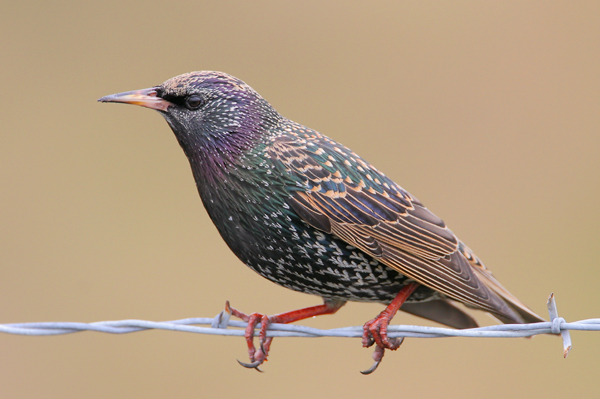
Photograph © Greg Lavaty.
The European Starling is a chunky, dark bird with a short tail, long wings, and a long, pointed yellow beak. The breeding male is glossy black with metallic green and purple highlights, and has some small buff and white spotting. The female is like the male but has more spotting on the head and breast.
Juvenile European Starlings are mostly gray with a black bill, have some spotting, and a white throat. In the winter, starlings are heavily spotted with white, have brown in the wings, and a black bill.
Starlings are adaptable birds that feed on grain, seeds, berries and other fruits, and invertebrates. They pick berries and fruits while perched in trees but do most of their foraging on the ground.
This species is very social and usually occurs in flocks. They were introduced to North America from Europe and are presently common in Oklahoma. We see European Starlings on farm fields, in cities and towns, at feeders, and other open habitats throughout the state.
House Sparrow
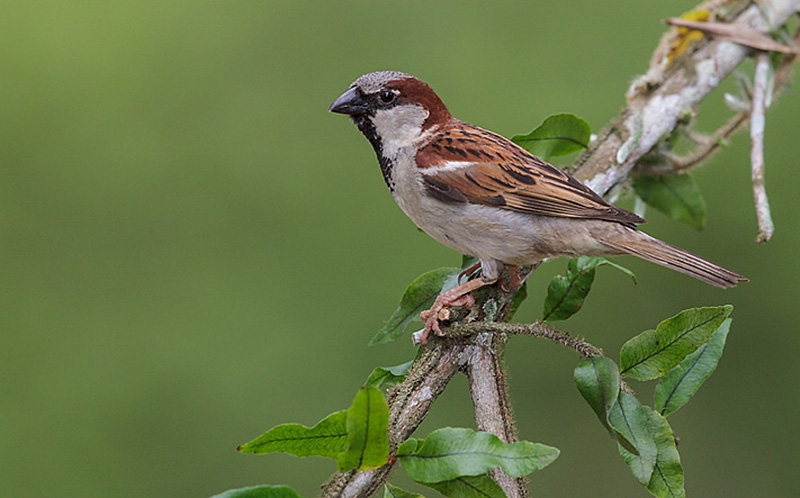
House Sparrow (Passer domesticus) perched on a branch in the Atlantic rainforest of southeast Brazil.
The House Sparrow is a common, brown bird of urban areas and other habitats. The males of this well-known species are brown and gray with chestnut on the head. They can have gray or white cheeks, have a conical black bill, and have black on the throat and around the eye.
They also have brown upperparts with some black markings, a bit of white in the shoulder, and gray underparts. Female House Sparrows lack the male’s head pattern, have paler bills, and a buff eyebrow going back from the eye.
This species feeds on seeds, grains, insects, garbage, and other food items. It picks food from the ground and can visit and dominate bird feeders.
Like the European Starling, House Sparrows were introduced to North America and have become common birds in most places. In Oklahoma, we hear the friendly chirping of these birds in towns, cities, parks, and around farms.
They form small flocks, especially during the winter months. Such flocks can occasionally include a Dickcissel or other small bird.
Grasshopper Sparrow
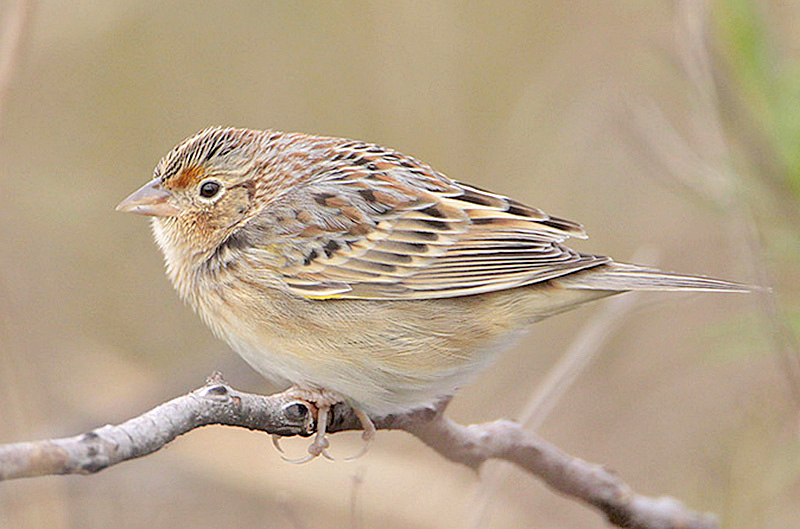
The Grasshopper Sparrow is a small, pale brown sparrow with a flat head and a fairly large conical bill. It is mottled brown above with some dark and white streaks, and is white and buff below. The Grasshopper Sparrow also has a white line with black border on the center of the crown, a small yellow spot near the eye, and a narrow white eyering.
It has a grayish buff eyebrow, a dark line going back from the eye, and small reddish marks on the side of the neck. Both sexes of this species look the same and also have pink legs, and a bit of yellow in the shoulder of the wing.
In summer, Grasshopper Sparrows eat a lot of grasshoppers and other insects but also eat some seeds. During the winter, these small sparrows mostly feed on seeds. They catch and pick all of their food from the ground and need bare ground for foraging.
This species is a summer resident of grassy habitats throughout the state. Its small size and high-pitched song make it very easy to overlook.
Scissor-tailed Flycatcher
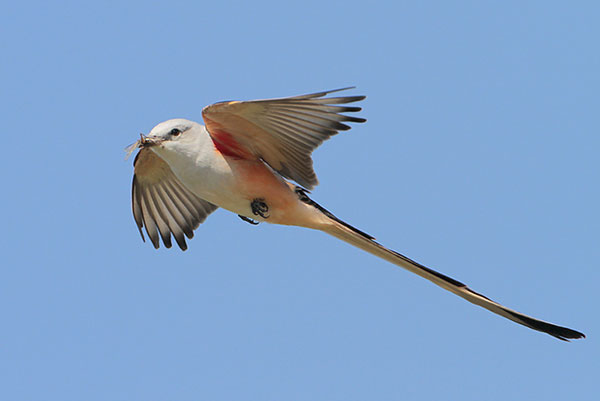
The Scissor-tailed Flycatcher is an elegant, medium-sized flycatcher with a very long tail. It is white and gray on the head, breast, and back, and has salmon coloration on the belly and undertail. This species also has a bit of reddish on the back, long black wings with white edging, and a fantastic, long, black and white, forked tail.
Male and female Scissor-tailed Flycatchers look alike except that males have longer tails. Young birds also have shorter tails and are pale yellow instead of salmon pink-orange. Both young and adult birds have stubby black bills and love to perch on posts, bushes, and trees in open areas.
This flycatcher feeds on grasshoppers and other insects. It catches them in flight, often after acrobatic maneuvers. It can be seen in fields and a variety of open habitats. With the state being situated at the center of its breeding range, it’s no wonder the Scissor-tailed Flycatcher is the Oklahoma state bird.
After breeding, large flocks of this beautiful bird migrate to dry forest habitats in Mexico and Central America.
Common Nighthawk
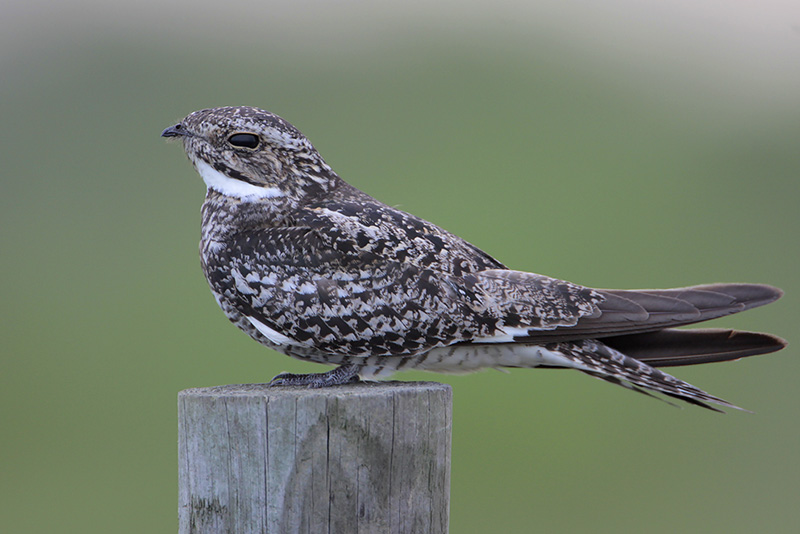
Photograph © Greg Lavaty.
The Common Nighthawk is a mottled gray and buff bird with a rounded head, and long, pointed wings. Despite its name, it is actually not one of the hawks in Oklahoma. It belongs to the same family as the Eastern Whip-poor-will, the “Nightjars.”
Common Nighthawks have a white mark at the base of their long, black primaries. They also have some white in their longish, forked tail. Both sexes have mottled gray, brown and black upperparts, and fine black barring on buff underparts. Males have a white throat whereas females have buff throats and less white in their plumage.
The Common Nighthawk got its name from its foraging behavior and looking somewhat like a falcon in flight. Like a swallow of the night, this nocturnal bird flaps and briefly glides while it catches insects with its wide mouth. In the evening, these interesting birds can often be seen “hawking” insects in the air, high overhead.
Its distinctive, nasal “peent” call can be heard in the summer night skies of Oklahoma over a wide variety of habitats including urban areas.
Hawks in Oklahoma
Red-tailed Hawk
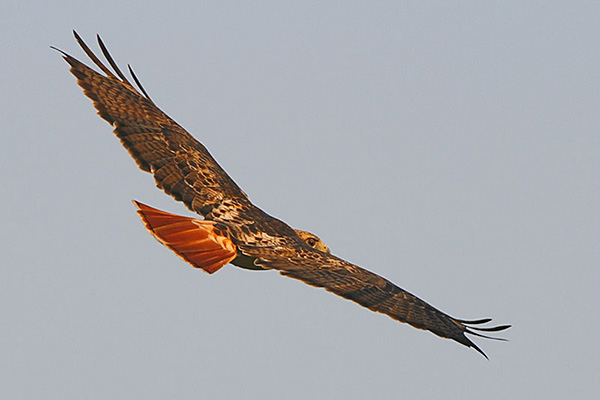
Of the hawks in Oklahoma, the Red-tailed Hawk is the most common species. Adults of this large and stocky hawk are easily recognized by their broad, reddish tails. They also have brown upperparts with some white marks, and dark brown markings on pale underparts.
This “belly band” is a good way to separate this species from most other hawks. Red-tailed Hawks also have broad wings with a pale, square patch at the base of the primaries. Young Red-tailed Hawks have a brown tail with dark barring instead of the adult’s distinctive reddish tail.
This common hawk feeds on small mammals, birds, snakes, and other small animals. It catches them with its sharp talons after swooping down from the sky or from a perch. In Oklahoma, we see Red-tailed Hawks all year long in open areas, woodlands, and other places. This is one of the more commonly seen raptors perched at the side of roads and highways.
The classic “hawk screech” heard in movies and on television shows is a recording of a Red-tailed Hawk. In Oklahoma, we hear this same vocalization in many places.
Related: All Birds of State Information
Swainson’s Hawk
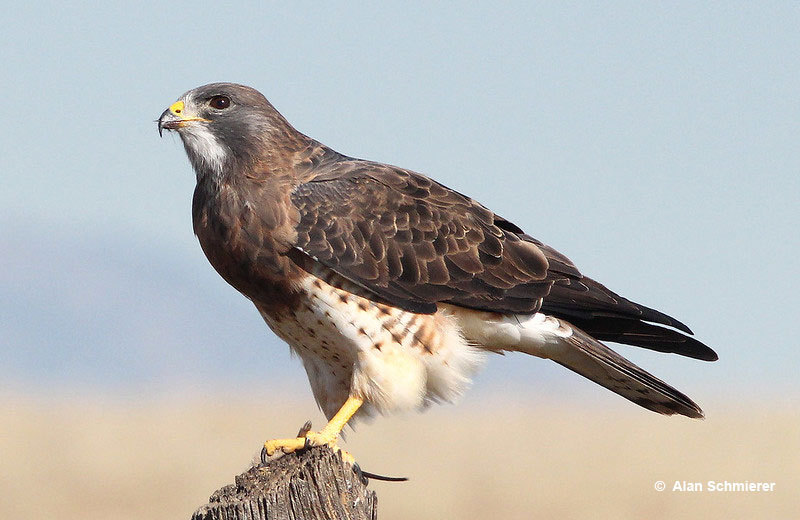
© Alan Schmierer
The Swainsons’ Hawk is a large hawk with long wings and a longish tail. Most are dark brown above and have a brown breast on white underparts. However, they can also be entirely brown below, or have reddish underparts with a brown breast. Swainson’s Hawks also have a white throat, grayish tail with faint dark barring, and white on the uppertail coverts. This is the part of the tail where it meets the body of the bird.
In flight, the Swainsons’ Hawk holds its long wings in a slight “V” shape, and has blackish flight feathers. Juveniles have varying degrees of mottled underparts but always have white throats and dark flight feathers on long pointed wings.
This hawk species feeds on small mammals, birds, and reptiles. It catches these prey items by swooping down from a perch or after flying high overhead. Swainson’s Hawks also forage on the ground for grasshoppers and other large insects, especially on their wintering grounds in Argentina.
In Oklahoma, this raptor species occurs in prairies and other open habitats.
Red-shouldered Hawk
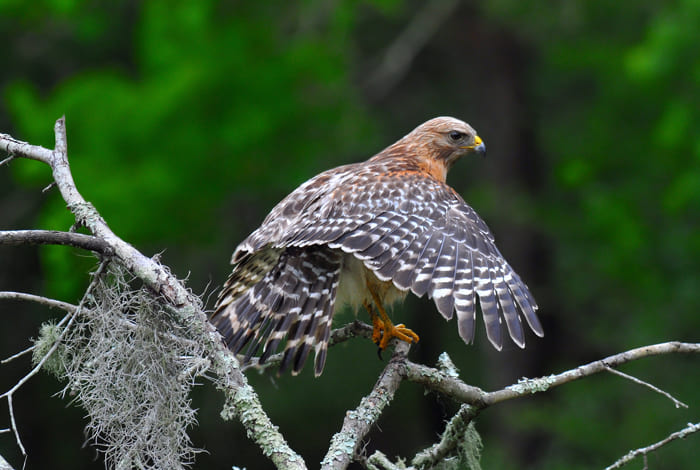
The Red-shouldered Hawk is a medium-sized hawk with longish wings and a fairly long tail. This beautiful raptor is reddish brown and red-orange on the head and underparts. It has some white markings on a brown and gray back, and black and white wings with a reddish shoulder.
In flight, it’s easy to see the narrow white bands on the blackish tail, and a pale crescent-shaped mark on the base of the primaries. This pale mark helps separate this species from other hawks. Juveniles also have this field mark but are otherwise dark brown above, and with dark brown streaks on white underparts.
The Red-shouldered Hawk preys on small animals, especially chipmunks and Meadow Voles. It also catches frogs and snakes, and occasionally attacks small birds at feeders. It catches food by dropping down on the animal from a low perch.
In Oklahoma, Red-shouldered Hawks occur in woodlands in the eastern part of the state. In forested areas, we often hear their jay-like “Keeur, Keeur, Keeur” call.
Broad-winged Hawk
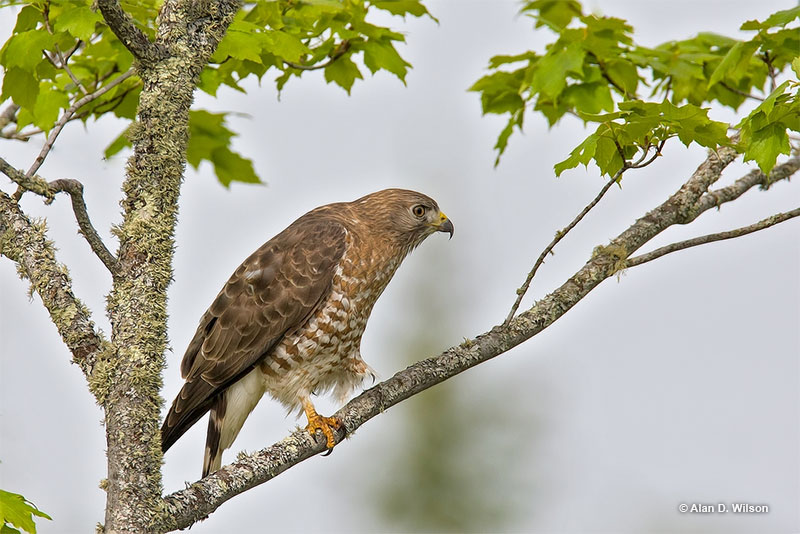
© Alan D. Wilson
The Broad-winged Hawk is a smallish, crow-sized raptor. This species has dark brown upperparts with some pale marks and has reddish-brown barring on white underparts. This species has a pale throat bordered with a dark mark on each side, and a broad, dark tail with broad white bands.
Juvenile Broad-winged Hawks are similar but have streaked instead of barred underparts, and fainter bands on the tail. In flight, the wings of both adult and young birds have a thick black border on the edge of the primaries and other flight feathers. The shape of the wings in flight has also, often been compared to the shape of a paring knife.
Broad-winged Hawks mostly feed on frogs, insects, and small mammals. They catch their prey by swooping down onto the animal from a perch. This small raptor lives in a variety of wooded areas but does especially well in wooded swamps and other forests near wetlands.
In Oklahoma, Broad-winged Hawks are common summer residents in easternmost part of the state. In fall, they migrate to Central and South America for the winter.
Cooper’s Hawk
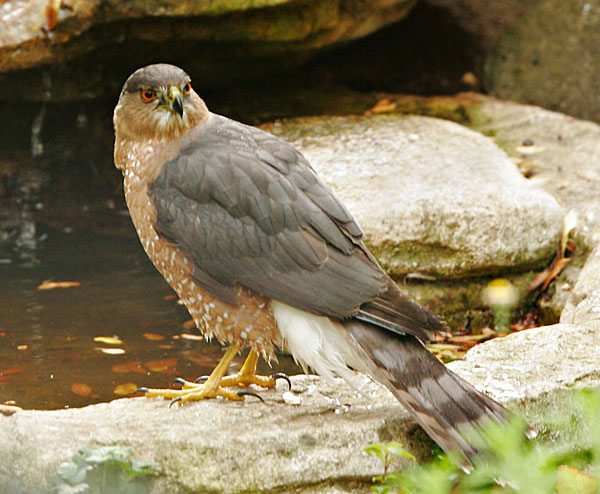
The Cooper’s Hawk is a common raptor with a long tail, and a blocky, square-shaped head. Adult Cooper’s Hawks are slate, blue-gray above, and have reddish-orange barring on the underparts. They also have red eyes, can show a dark cap, and have rounded tails with dark bars.
Young Cooper’s Hawks are mostly mottled dark brown above and have dark brown streaks on pale underparts. Like the adults, their rounded tail and large head are good field marks to separate them from the similar Sharp-shinned Hawk.
This species occasionally soars but usually flies like other Accipiters; with deep flaps followed by glides. In flight, its wings are often held straight out from the body and do not look bent.
The Cooper’s Hawks is an important predator of Mourning Doves, pigeons, and other medium-sized birds. It catches these with its long, needle-sharp talons by surprise or after chasing them through wooded areas. This raptor also feeds on squirrels and other small mammals that it catches on the ground.
As in other places in its range, the Cooper’s Hawk stalks bird feeders and woodlands throughout the state of Oklahoma.
Owls in Oklahoma
Great Horned Owl
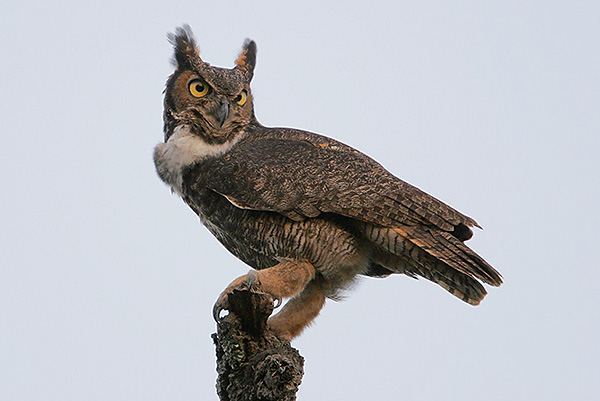
Photographs © Greg Lavaty.
The Great Horned Owl is a big and powerful raptor. As in other parts of its range, in Oklahoma, this species is the top avian predator of the night. The biggest of the owls in Oklahoma, this bird is as large as a big Red-tailed Hawk.
This bulky owl has a narrow white patch between the throat and breast, “ear tufts”, and a reddish-brown face with a black border. It also has yellow eyes, a black bill, and blackish barring on gray-brown underparts. As with other owl species, males are smaller than females. It also has mottled gray-brown plumage, long, broad wings, and a broad tail with black bands.
Great Horned Owls in Oklahoma feed on a wide variety of prey. They take rats, mice, small birds, rabbits, nestling raptors, and other animals. When possible, they even catch animals as large as the Great Blue Heron.
The Great Horned Owl is active at night and catches prey after swooping down on it from a perch. In Oklahoma, we hear its deep hooting calls in every habitat, even in some urban areas.
Barred Owl
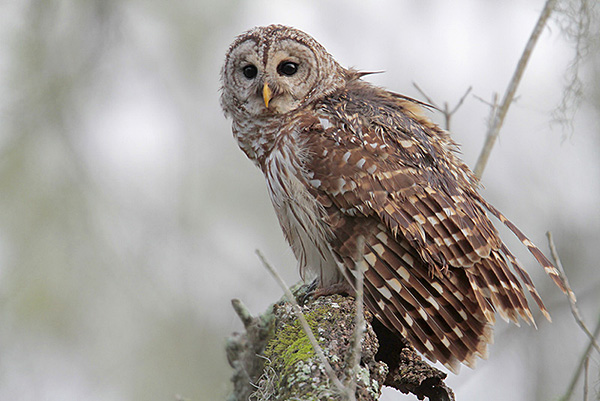
Photograph © Greg Lavaty.
The Barred Owl is a fairly large owl species with dark brown eyes, a rounded head, and a pale face with a dark border. It has grayish-brown upperparts with white markings, and dark brown streaks on pale underparts. This species also has long, rounded wings with white bands and markings, and a medium-length, broad, dark brown tail with white bands.
Both sexes look alike although, in common with most raptors, females are larger than males. Barred Owls also have sharp talons on feathered legs, and narrow yellow beak.
The Barred Owl feeds on a wide variety of prey items. These can include crayfish, mice, rats, chipmunks, insects, and other animals. Although it doesn’t catch as many birds as some other species, it won’t pass up an opportunity to take birds as big as American Robins and grouse.
This owl is mostly nocturnal and catches prey by swooping down onto it from perches in wooded areas. In Oklahoma, we often hear their song in the central and eastern part of the state. They say, “Who cooks for you? Who cooks for you all?”
Burrowing Owl
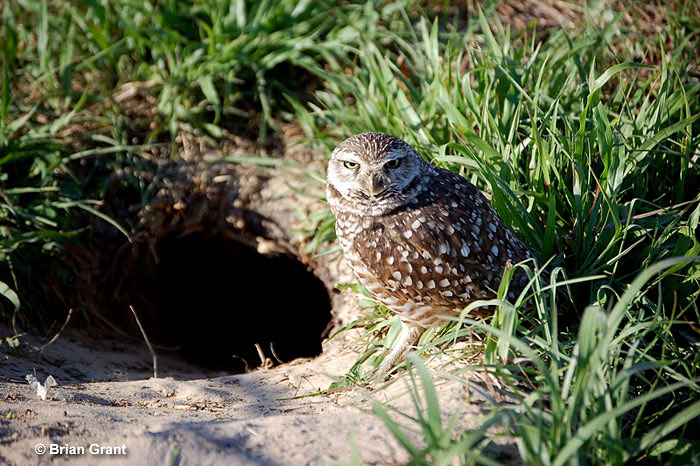
The Burrowing Owl is a pint-sized owl that lives in a hole in the ground. Yes! True to its name, this small owl of open plains roost and nests in burrows. It has a rounded head, small white spots and marks on brown upperparts, and pale brown spotting on white underparts.
This cute owl also has yellow eyes on a pale grayish-buff face, and white eyebrows and a white throat. It has a short, broad tail, and long, feathered legs. Young Burrowing Owls are buff and brown and lack the spotting of the adult birds.
Burrowing Owls mostly feed on grasshoppers, crickets, beetles, other insects, and small mammals. However, when they see the chance, they can also catch small snakes, frogs, and small birds. This species hunts insects by walking along and snatching prey with its talons. It usually catches larger prey by watching from a perch, and then flying to catch the animal with its talons.
Burrowing Owls are active both during the day, and at night. They live in open and arid habitats of western Oklahoma.
Barn Owl
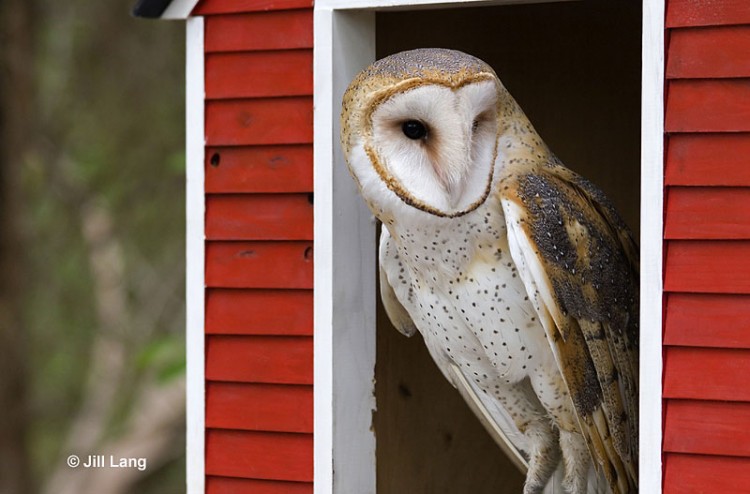
The Barn Owl is a large, ghostly pale bird. They have a round head with a distinctive, beautiful, white heart-shaped face, and white underparts with some buff and small dark speckling. Their upperparts are orange-buff and gray with small white and dark spots.
Barn Owls have long, broad wings used for flying and gliding over fields and other open habitats. They also have long, white feathered legs with long, sharp talons on large gray feet. Both sexes look similar except males are paler below than females.
This unique owl species hunts for rats and other rodents in prairies, open grassy fields, and other open habitats. If enough food is available, and they have a safe place to roost, Barn Owls can also thrive in urban areas. In some parts of its big range, this species even lives in church steeples.
The Barn Owl is nocturnal and hunts for prey by flying low over open habitats on silent wings. After locating prey with its very acute hearing, the owl plunges to the ground and catches the animal with its talons.
Barn Owls occur throughout Oklahoma.
Eastern Screech-Owl
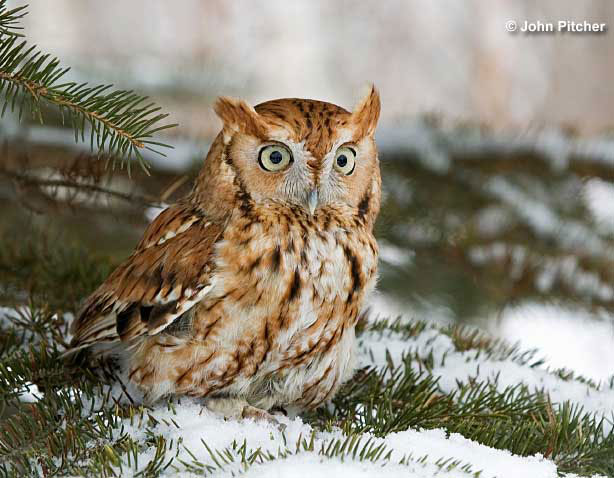
The Eastern Screech-Owl is a small owl species with “horns” or ear tufts. Nearly the same size as an American Robin, this common owl species has mottled brown and gray plumage above, and dark streaks and barring on pale underparts. It can be mostly gray, brown, or have a rich, reddish-brown color.
Eastern Screech-Owls also have a greenish bill, a narrow black border on the face, and white markings on the face that look like an “X”. Both sexes look the same although females are a bit larger than male birds.
Eastern Screech-Owls feed on various small animals. Their prey can include voles, mice, frogs, small birds, insects, and other creatures. All of their hunting takes place at night and they catch prey by swooping down onto it from a perch. During the day, they hide exceptionally well, often in tree cavities.
One of the more common owls in Oklahoma, its tremulous, whistled song can be heard in wooded areas throughout the state.
See more: Owls in Oklahoma
Woodpeckers in Oklahoma
Red-bellied Woodpecker
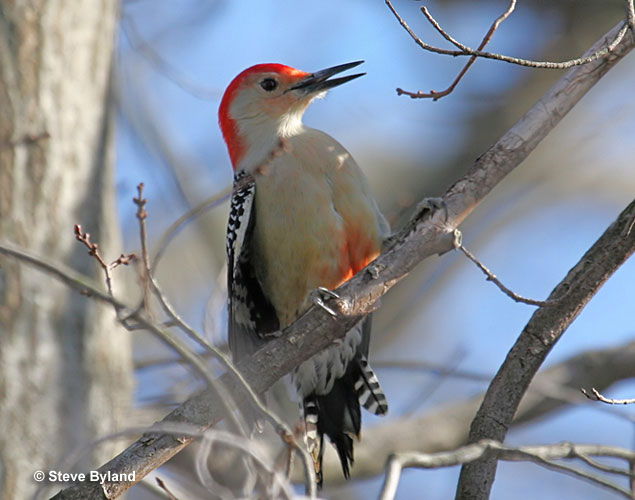
Red-bellied Woodpecker
The Red-bellied Woodpecker is one of the most common woodpeckers in Oklahoma. This bold woodpecker species is white with red on the crown and back of the neck, and has black and white barring on the back and wings. It also has a black and white tail, and a white rump.
Female Red-bellied Woodpeckers resemble males except their heads have less red. True to this bird’s name, both sexes also have red on the belly but this can be hard to see.
As with other woodpeckers, its strong tail feathers have pointed tips to support the bird as it hitches up tree trunks. In flight, this woodpecker’s long wings show a white crescent-shaped patch on the base of the primaries.
Red-bellied Woodpeckers are very opportunistic and feed on everything from insects to small lizards, fruit, nuts, and seeds. They forage by picking food off of trunks and branches, pecking into wood, and picking berries and fruits while perched. This species is also a regular at bird feeders throughout Oklahoma.
In Oklahoma, we see this bird in every type of wooded habitat.
Red-headed Woodpecker
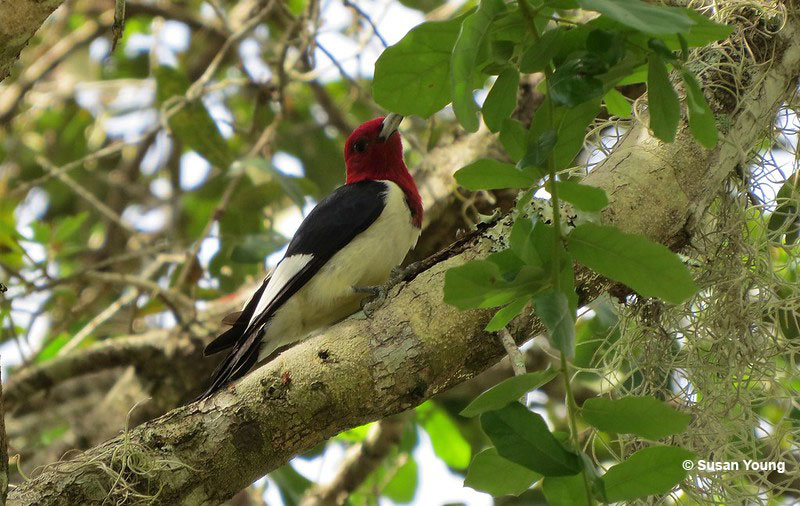
© Susan Young
The Red-headed Woodpecker is a beautiful, boldly patterned woodpecker species with a deep red head. It also has a glossy blue-black back, a bit of white on its black tail, and a snow-white rump and underparts. This species has a large white patch in its wings and also has white on half of the underwing.
Male and female Red-headed Woodpeckers look alike but juveniles lack the red head, have dark gray instead of black, and gray markings on the underparts.
This species is omnivorous and feeds on everything from acorns and seeds to fruits, insects, bird eggs, and nestlings. Red-headed Woodpeckers are often seen in flight as they sally for insects like a flycatcher. They also use their chisel-like gray bills to take beetles from bark, and swoop to the ground to pick up other food items.
In Oklahoma, Red-headed Woodpeckers are a common and conspicuous bird in many parts of the state. We see them and hear their squawk-like call in open oak forests, parks, forested riparian zones, wooded swamps, and other situations.
Downy Woodpecker

Downy Woodpecker Male
The Downy Woodpecker is the smallest woodpecker species in Oklahoma. This dainty bird has a black and white head, a white back, and white underparts. It also has white barring on black wings, a black and white tail, and a short, straight black bill.
Male and female Downy Woodpeckers look the same but the male has a small red spot on the back of its head. The female lacks this spot and is a bit smaller, but the size difference is very hard to tell. Juveniles have a bit of red on the crown.
Downy Woodpeckers feed on beetles and a wide variety of insects. They also eat some fruits, seeds, and tree sap. This is one of the more common woodpecker species that visit feeders, and they often do so in gardens in suburban areas.
The Downy Woodpecker forages by pecking into bark and gleaning food from trunks and branches. For protection, pairs often feed with chickadees and other small birds.
In Oklahoma, the Downy Woodpecker is a common species of wooded habitats. We hear and see this handsome little woodpecker in every part of the state, including parks and gardens.
Pileated Woodpecker

The Pileated Woodpecker is the largest of the woodpeckers in Oklahoma. Around the size of a crow, this big, crested woodpecker is black with white on the face, neck, and underwing. The male has red from the crest to the bill, and a small red moustache mark. The female is similar but only has red on her crest.
This woodpecker flaps its big, rounded wings for quick, undulating flight. When flying, a white patch is visible at the base of the primaries, and the front lining of the underwing makes big white flashes.
Pileated Woodpeckers also have long, pointed tails. They feed on beetle grubs, carpenter ants, fruits, and nuts. In some places, these big woodpeckers will visit feeders, but mostly to eat suet.
They use their strong blackish bills to peck into decaying logs and dead and live trees. Pileated Woodpeckers make big, rectangular holes, the presence of which are good signs that this species is nearby.
The deep, laughing “kek,kek,kek” calls of the Pileated Woodpecker are often heard in eastern Oklahoma.
Hairy Woodpecker
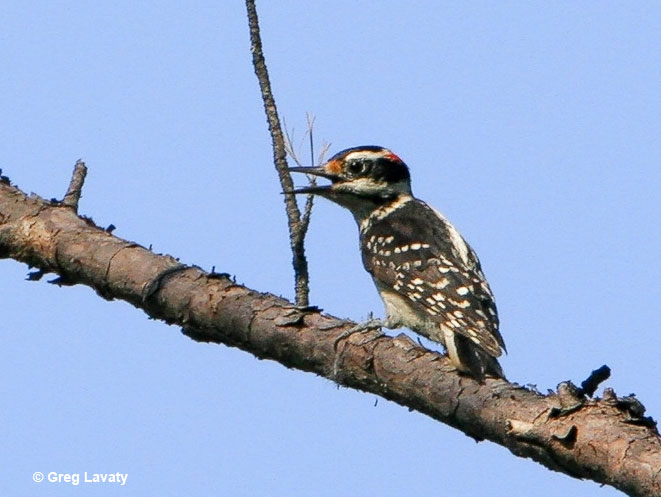
Hairy Woodpecker
The Hairy Woodpecker is a small to medium-sized, black and white woodpecker of mature woodlands. It has a long, dark, chisel-like bill, a black and white head, and a white back. Male Hairy Woodpeckers have a small red spot on the back of the head. Females lack this red spot but are otherwise similar. Young birds have some red on the crown.
This species has white barring on black wings, white underparts, and a pointed black tail with white outer tail feathers. Unlike the very similar Downy Woodpecker, it does not have a prominent white tuft at the base of the bill.
Hairy Woodpeckers feed on grubs and other insects along with a variety of fruits and seeds. This woodpecker forages by picking food from trunks and branches but mostly by pecking into wood. When it detects a grub, the bird snags it with its long, spear-like tongue.
Hairy Woodpeckers can also visit feeders for nuts, seeds, and suet. In Oklahoma, we hear the sharp calls of this woodpecker and see it in woodlands with mature trees.
Ladder-backed Woodpecker
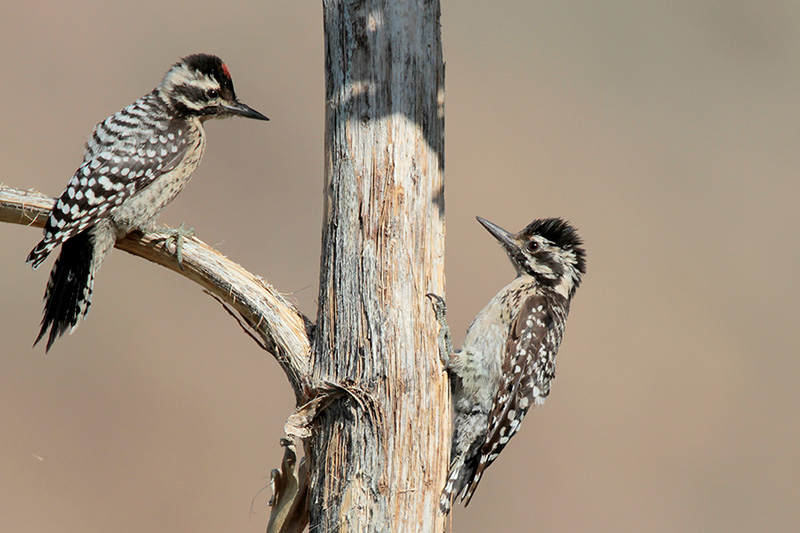
The Ladder-backed Woodpecker is a small woodpecker species. It is bigger than a Downy Woodpecker but smaller than a Hairy Woodpecker and has black and white barring on the back. The Ladder-backed Woodpecker also has a black and white face, and some small black spotting on white underparts.
The male has red on the crown while the female has black, and they have black rumps, and black and white, pointed tails. Juveniles also have red on the crown.
They use their long black wings with white barring to fly between bushes and foraging areas. Like other woodpeckers, they have undulating flight.
These woodpeckers feed on beetles and other insects. They get food by pecking into cactus, mesquite, and other arid vegetation, often near the ground.
Like most woodpeckers, Ladder-backed Woodpeckers occur in pairs that defend their territory from other, similar-sized woodpeckers.
This species is a bird of arid habitats in the southwestern USA, Mexico, and Central America. In Oklahoma, we see it and hear its Downy Woodpecker-like calls in the western Panhandle, and a few other parts of western Oklahoma.
Frequently Asked Questions about Birds of Oklahoma
What is the most common bird in Oklahoma?
There are many common birds in Oklahoma. Some of the most common are the Scissor-tailed Flycatcher, House Sparrow, Turkey Vulture, and the Northern Mockingbird.
What are the rare birds in Oklahoma?
The Lesser Prairie-Chicken is one of the rarest birds in Oklahoma. Its range has been greatly diminished, and it is listed as “vulnerable” on the IUCN Red List. This is one step from being globally listed as endangered with extinction.
The Black-capped Vireo is another threatened species with much of its breeding range in central Oklahoma.
What are the largest birds in Oklahoma?
The largest birds in Oklahoma are the Mute Swan, Trumpeter Swan, American White Pelican, Bald Eagle, and the Whooping Crane.
How many bird species are native to Oklahoma?
There are 488 species on the Oklahoma bird list.
Read next: Owls in Oklahoma

